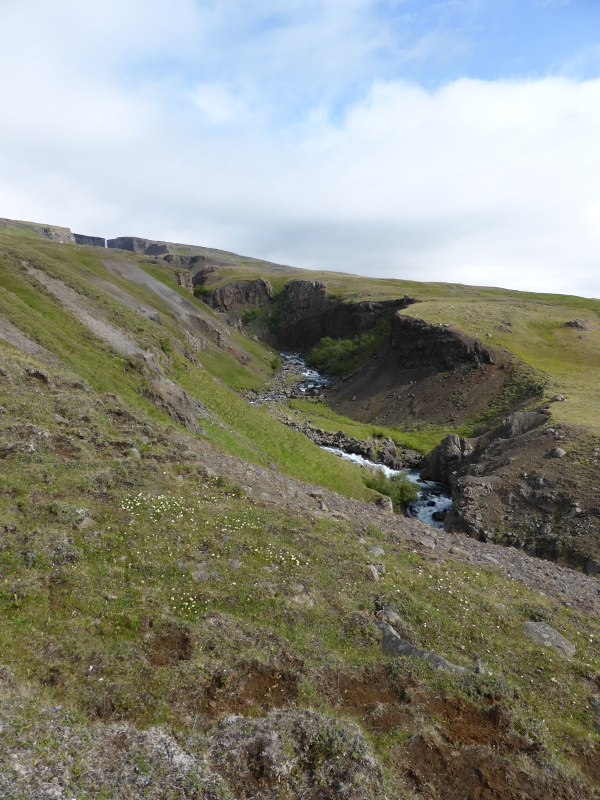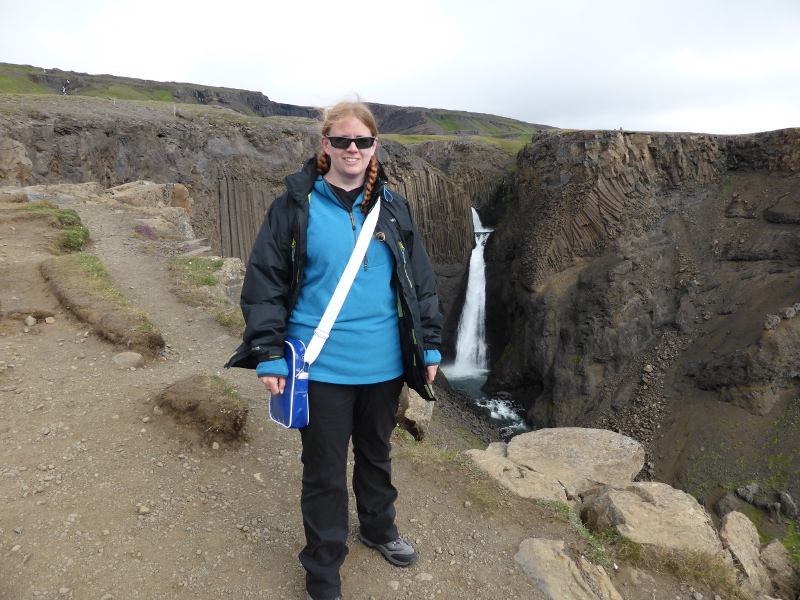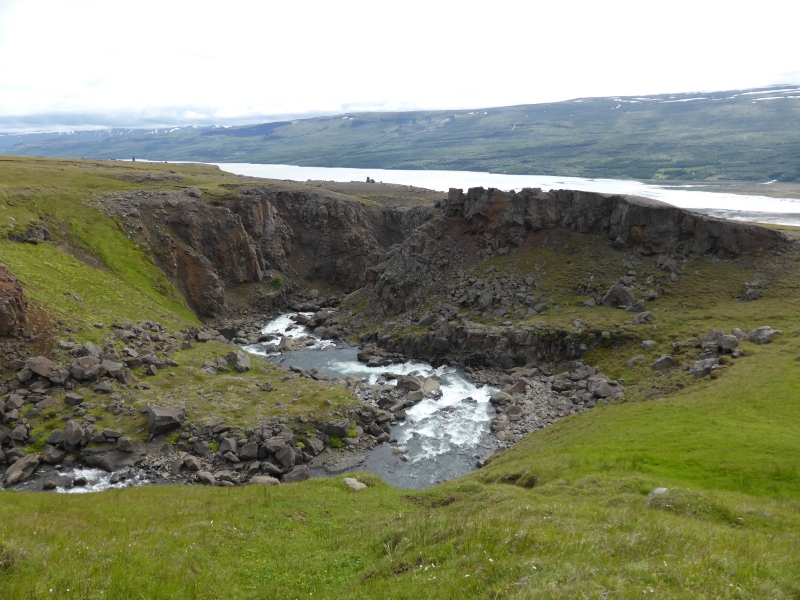I like to climb a mountain when I’m in Iceland in the summer and although, technically, that didn’t really happen this year (I was kind of slightly really ill the whole time and just didn’t have the energy; plus, there aren’t that many handy climbable mountains in the east), I did find Hengifoss, a nice waterfall that was worth an hour’s hike up the side of a mountain.
Hengifoss is on the north-west side of a lake that runs south-west to north-east. The lake, Lagarfljót, also called Lögurinn, is technically not really a lake but a bulge in the Lagarfljót river. I flew over it on the way to Egilsstaðir, which sits at its north-eastern point and there’s a lovely bit where a nice peacock-blue freshwater river joins the murkey yellow-grey glacial lake.
I drove around this nice lake because I’d been told that there are unusual amounts of woodland around its banks. To quote my guidebook:
The woodland is mostly birch, though mature plantations of much larger ash, spruce and larch are wildly popular with Icelanders, who are struck by the novelty of seeing vegetation that is taller than they are.
Incidentally, there’s a monster living in the Lagarfljót, much like the Loch Ness Monster, which has been seen semi-regularly since 1345. I didn’t spot it
I drove down the south-east bank until I reached the bridge which crosses it so you can drive back up the other side and I spotted a very interesting waterfall on the other side.
I think the mountains here might be quite soft – waterfalls do tend to carve out big rounded canyons and this one caught my eye. I thought I’d see if I could investigate further and bingo! There’s a little car park with information boards at the bottom of a trail. Had I bothered to pay attention, I’d have realised it’s detailed in my guidebook and says it takes about an hour. But looking at the waterfall and looking at the distance, I thought it would be a quick twenty minutes and I’d be back in the car- which is why, by the way, I travelled so light. I put on my raincoat for a windproof layer, because although the sun was out, there was just enough Arctic breeze to make it pretty cold and then all I carried was my car key, my camera, half a bar of chocolate and carton of orange juice. Given how close I thought it was and the weather conditions, it seemed absolutely unnecessary to take anything else with me (but I did change from my mountain sandals into my actual boots).
It’s a very nice walk. It more or less follows the gorge up, over what I can best describe as the Icelandic equivalent of heathland, up to the first waterfall, Litlanesfoss.
Litlanesfoss is interesting because it’s surrounded by basalt columns. In the UK, we make a huge deal out of the Giant’s Causeway but in Iceland, columns like this are so common that people barely glance at them on the way up to Hengifoss, and these ones are pretty spectacular. So spectacular that I found a stranger and pleaded for a photo with them.
This is probably a good time to point out that first, the proper gravel path gave way to foot-worn track a long time ago and also that the track gets dangerously close to the edges at times, and in rock this soft, which is mostly made of compacted ash, I think, it crumbles.
Just up from Litlanesfoss were three sheep, a mummy and her two fairly large babies and don’t you tell me these sheep don’t know they’re having their photos taken. Oh, the posing!
It’s amazing how long you can be distracted by sheep for.
After the sheep, you keep climbing up, past more gorge, cross the river by a tiny wooden bridge and then at last you come to a viewpoint.
Now you can see why I took an interest in this particular waterfall. It’s got red stripes in between the layers of grey volcanic rock! From what I understand, first a layer of grey basalt is laid down. Then ash falls on top of it. In time, that turns into soil and then clay and iron form in it. Next eruption, that layer is covered, it reacts with oxygen and it turns red. Repeat a few times and you end up with this nice striped effect. It does look a bit like a waterfall falling over a quarry but this is definitely all natural.
 You can follow the path right up to the base of Hengifoss, as you can see in this picture (see the teeny-tiny people in the green patch on the left?) but I didn’t bother. Not because I didn’t want to make the effort to walk another ten minutes on relatively flat ground but because I felt Hengifoss had reached optimum prettiness and I didn’t think it was going to get any prettier when the rock was looming over me and I was being sprayed.
You can follow the path right up to the base of Hengifoss, as you can see in this picture (see the teeny-tiny people in the green patch on the left?) but I didn’t bother. Not because I didn’t want to make the effort to walk another ten minutes on relatively flat ground but because I felt Hengifoss had reached optimum prettiness and I didn’t think it was going to get any prettier when the rock was looming over me and I was being sprayed.
Hengifoss is Iceland’s second or third highest waterfall, depending on where you’re reading it. The National Land Survey of Iceland says the third, at 128m, but as they’re missing Fagrifoss, which is definitely higher than some on their list, I’m not going to take them too seriously. But it’s certainly a relatively rare straight fall – a lot of them tend to tumble down the rocks.
The walk down wasn’t much quicker. Despite having stopped to take photos of everything on the way up, I stopped to take more on the way down.
I had new boots for my birthday but the purposes of breaking them in before I went to Iceland, I actually had them at the beginning of July. This was the first semi-serious walk they’re done and I’m really suspicious that they still haven’t started rubbing or feeling sore or uncomfortable anywhere. Boots that are broken in straight from the box? That just seems wrong.

















